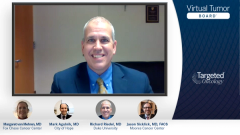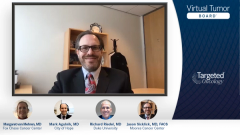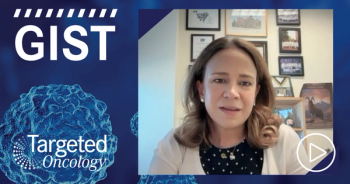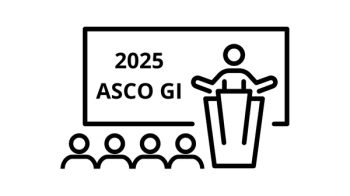
Case 3: The Role of Avapritinib in GIST
The panel discuss the use of avapritinib in GIST, including doses, toxicities, and secondary resistance to treatment.
Episodes in this series

Richard Riedel, MD: I have had the ability to use avapritinib in a small cohort of patients. I have seen cognitive effects, and it’s something we need to be aware of. Certainly, community-based providers who may not have a robust GIST experience need to be aware of it. The findings can be subtle in some patients. They can be more significant in others. We need to be mindful of that, consider early dose reduction or dose holds and drug interruptions. Left untreated or unrecognized, this can cause problems.
Margaret von Mehren, MD: Yes. In the phase 1 study the dose did seem to correlate with the incidence. While we went up to 600 mg in that study, at the higher doses the incidence was much higher. Dose interruption and, if it’s persistent, dose decreases are useful ways of mitigating.
One of the things that is challenging about that particular adverse effect is that the issues patients present with are often memory issues. Particularly if many of these patients are in their older years, memory is something that when you’re older, when you are ill with a disease, you may not be at your best. Sorting out if this is related to the disease or the medication is something to monitor closely. I have always asked patients about their memory, but it’s good, as Mark was saying, to ask friends and family as well because they sometimes are not aware of it.
Mark Agulnik, MD: If it was subtle, I don’t think there’s much I would do for anything profound. I had only 1 case in which it was profound. I lowered the dose, and it did normalize. It was impressive to see how it normalized.
Margaret von Mehren, MD: I’ll ask patients questions like, “Are you having issues finding words?” Because sometimes that will be the way it’s manifested. “Are you forgetful about where you left things?” Those types of things. Occasionally, patients have also had issues with mood, where they’ve had a change in their mood. That’s another thing I will ask them about to make sure that’s also not being affected.
Richard Riedel, MD: Meg, you raise a good point about talking to family and friends. One particular patient comes to mind who had more significant and severe cognitive effects. In talking with the family, only in retrospect did they realize that things have been going on for several months. It was very subtle and stayed subtle, and it was only upon looking back that they felt maybe this has been going on for a while. Educating patients, educating family members, and friends and certainly as a provider being vigilant about this is going to be important.
Margaret von Mehren, MD: We’ve talked a lot about different scenarios. One of the things we’ve hinted at is that as these tumors evolve, they tend to develop additional resistance, and these are because of secondary mutations. If you have some of that information, does that change how you manage these patients at all?
Richard Riedel, MD: That’s a great question that is best answered in a clinical trial. I don’t have that information often, although recently I had a patient who underwent resection of oligometastatic disease who did mutational testing. They had a defined secondary mutation. That didn’t impact the treatment decision, but I wondered to myself if it was a different mutation, would that impact it? In my practice, I have not changed treatment decisions based on subsequent mutational testing. I’d be interested to know what others do. Jason, what occurs at your institution? I follow the paradigm that we’ve outlined here: imatinib, sunitinib, regorafenib, ripretinib, and avapritinib for PDGFRA D842V, for example.
Jason Sicklick, MD, FACS: In our experience, I haven’t seen a PDGFRA secondary mutation. There are obviously the data that were recently published by Mike Heinrich’s group and Sebastian Bauer’s group in Cancer Discovery describing the secondary resistance mutations to avapritinib. I’ve yet to see them in our patient population. But as you alluded to, clinical trial is the potential way to go in that situation.
In terms of tailoring therapy to other secondary resistance mutations, we are on clinical trials that we’re running here through our precision medicine program. In those situations, we are occasionally in select patients doing customized combination therapies under the setting of a clinical trial, combining agents where there are either phase 1 data available or dose-reducing patients under the clinical trial in order to target the multiple alterations identified that are the source of potential resistance in those cases.
Mark Agulnik, MD: Moving forward, this would be incredible: In 5, 10 years, when we have these discussions, if we could use blood instead of biopsies. That would be the easiest way to get this done. But it would be interesting to see if we could have a tailored approach for every patient and use the data that we already know with respect to sensitivities of resistance to choose the best path forward, incorporating all these drugs and others potentially but finding the right sequence that fits the patient. Not just 1 size fits all.
Margaret von Mehren, MD: One of the things we’ve often focused on is the secondary mutations in KIT or PDGFRA, but it’s clear that other pathways are being affected. Looking at some of those other combinations may be helpful. Or if you can’t hit the pathway with a drug that targets KIT, if that’s the driving mutation, a combination with something that affects the pathway lower down might give you more bang for your buck and lead to growth inhibition or tumor cell death. Certainly, many labs, including my collaborator at Fox Chase [Cancer Center] are looking at those things and findings interesting things. The question is if they will be translatable in the clinic and how we’ll be thinking about things in the future.
Transcript edited for clarity.













































